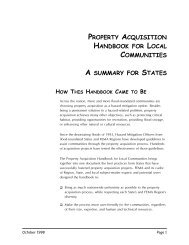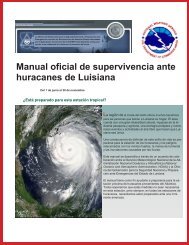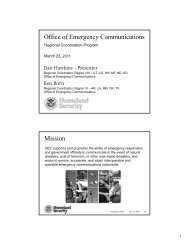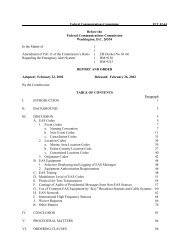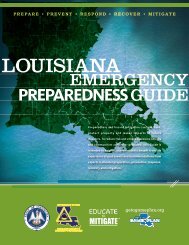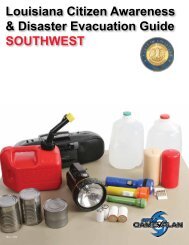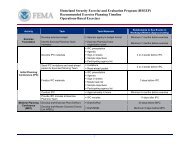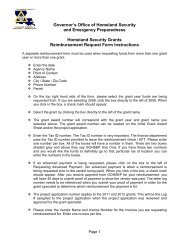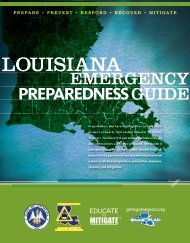LOUISIANA DEPARTMENT OF PUBLIC SAFETY
LOUISIANA DEPARTMENT OF PUBLIC SAFETY
LOUISIANA DEPARTMENT OF PUBLIC SAFETY
You also want an ePaper? Increase the reach of your titles
YUMPU automatically turns print PDFs into web optimized ePapers that Google loves.
DESIGNATOR*R7-COORDCALL*R7-COORDTK-1*R7-COORDTK-2*R7-BOLO (LAW ENFORCEMENT RADIOS ONLY)*R7-TACTICAL (LAW ENFORCEMENT RADIOS ONLY)*R8-COORDCALL*R8-COORDTK-1*R8-COORDTK-2*R8-BOLO (LAW ENFORCEMENT RADIOS ONLY)*R8-TACTICAL (LAW ENFORCEMENT RADIOS ONLY)*R9-COORDCALL*R9-COORDTK-1*R9-COORDTK-2*R9-BOLO (LAW ENFORCEMENT RADIOS ONLY)*R9-TACTICAL (LAW ENFORCEMENT RADIOS ONLY)USEREGION 7 CALLINGREGION 7INTEROPERABILITY TALKREGION 7 INTEROPERABILITY TALKREGION 7 BOLO ANNOUNCEMENT & DISPATCHERTO DISPATCHER ONLYREGION 7 LAW ENFORCEMENT INTEROPERABILITYTALKREGION 8 CALLINGREGION 8 INTEROPERABILITY TALKREGION 8 INTEROPERABILITY TALKREGION 8 BOLO ANNOUNCEMENT & DISPATCHERTO DISPATCHER ONLYREGION 8 LAW ENFORCEMENT INTEROPERABILITYTALKREGION 9 CALLINGREGION 9 INTEROPERABILITY TALKREGION 9 INTEROPERABILITY TALKREGION 9 BOLO ANNOUNCEMENT & DISPATCHERTO DISPATCHER ONLYREGION 9 LAW ENFORCEMENT INTEROPERABILITYTALKB. Minimum requirementsIn order to accommodate subscriber units with a limited talkgroup capacity,the SIEC has identified the following talkgroups as a minimum requirement forall LWIN subscriber units with the capacity for less than 200 talkgroups perradio.DESIGNATOR*INTEROP-1*INTEROP-2*INTEROP-3*INTEROP-4*INTEROP-5*INTEROP-6*INTEROP-7*INTEROP-8*INTEROP-9*R(region number)-COORDCALL*R(region number)-COORDTK-1*R(region number)-COORDTK-2*(PARISH)-1*(PARISH)-2*(PARISH)-3*(PARISH)-43USELOCAL/STATE AGENCY INTEROPERABILITYLOCAL/STATE AGENCY INTEROPERABILITYLOCAL/STATE AGENCY INTEROPERABILITYLOCAL/STATE AGENCY INTEROPERABILITYLOCAL/STATE AGENCY INTEROPERABILITYLOCAL/STATE AGENCY INTEROPERABILITYLOCAL/STATE AGENCY INTEROPERABILITYLOCAL/STATE AGENCY INTEROPERABILITYLOCAL/STATE AGENCY INTEROPERABILITYREGION (region number) CALLINGREGION (region number) INTEROPERABILITY TALKREGION (region number) INTEROPERABILITY TALKDEDICATED (PARISH) INTEROPERABILITYDEDICATED (PARISH) INTEROPERABILITYDEDICATED (PARISH) INTEROPERABILITYDEDICATED (PARISH) INTEROPERABILITY
The ten mutual aid conventional channels detailed in section F of this policymust be programmed in every mobile and portable radio.C. Statewide Band UseThe SIEC has designated that all first responder interoperablecommunications occurring in Regions where equipment exists will utilize thestatewide LWIN system.The LWIN system talkgroups will be programmed by denoting an asterisk (*)followed by the talkgroup identifier. In verbal communications, this asterisk isreferred to using the word “STAR” (i.e. “switch to STAR R1-COORDCALL).When the word “STAR” is heard, this means the LWIN system.D. Interoperability Calling TalkgroupsAll subscriber units operating on the LWIN system will be programmed withdesignated interoperability calling talkgroups as listed above in Section II. TheSIEC has designated the “calling” talkgroup for each Region as COORDCALL.It is recommended that the appropriate calling talkgroup be continuouslymonitored by all first responder agency dispatch centers operating on theLWIN system. First responder agencies requesting mutual aid assistancefrom other agency first responders may utilize the calling talkgroup to makeinitial contact with the assisting agency. Once the assisting agency(s) havebeen contacted, the dispatcher or incident commander as appropriate willassign an interoperability talkgroup(s) and/or channel(s).4
Designated Calling Talkgroups:RegionLWIN Calling Channel1 *R1- COORDCALL2 *R2- COORDCALL3 *R3- COORDCALL4 *R4- COORDCALL5 *R5- COORDCALL6 *R6- COORDCALL7 *R7- COORDCALL8 *R8- COORDCALL9 *R9- COORDCALLE. Interoperability TalkgroupsAll subscriber units operating on the LWIN system will be programmed withdesignated statewide interoperability channels and talkgroups. The SIEC hasdesignated that during emergency events, whether local, regional orstatewide, the incident commander will determine talkgroup/channelassignments and that these assignments will take precedence over otherassignments for non emergency events.The requesting agency upon making contact with the assisting agency(s) willthen direct their radio traffic to either COORDTK-1 or COORDTK-2 within theirregion as designated by the incident commander. In the event thatCOORDTK-1 or COORDTK-2 is being utilized, the requesting agency canutilize any of the four parish talkgroups or ten INTEROP talkgroups that arenot being utilized.1) Local Talkgroups:All subscriber units operating on the LWIN system will be programmed withfour designated talkgroups for the parish in which the first responder agencyresides. In addition, the subscriber units are programmed with the four parishtalkgroups for each of the parishes within their designated region. The parishtalkgroups are available to first responder agencies for day-to-day andemergency operations requiring multi-agency communications within theparish; in addition to use for localized events in which agencies outside of theirparish provide assistance. Parishes are encouraged to develop their owninternal standard operating procedures use of the parish talkgroups.5
2) Regional Talkgroups:All subscriber units operating on the LWIN system will be programmed witheach of the nine Regional COORDCALL and COORDTK-1 and COORDTK-2talkgroups. For Law Enforcement Agencies only, the subscriber units areprogrammed with each of the nine Regional BOLO and Tactical Channels.While the Regional COORDCALL is a calling channel, in which requestingagencies can call other first responder agencies monitoring the callingchannel, the COORDTK groups are designated for regional day-to-day andemergency operations that require multi-agency, multi-jurisdictional and multiparishresponse.The incident commander will make the determination on whether to utilize thefour designated parish talkgroups in which the incident is occurring or theregional COORDTK groups for that region based on the size, participants andcommunication requirements of the incident.For large scale events, the incident commander is encouraged to utilize ICSForm 205 (Appendix J), Incident Radio Communications Plan, to assist in theassignment and use of talkgroups.3) Statewide TalkgroupsAll subscriber units operating on the LWIN system will be programmed withfour STATE talkgroups. These four talkgroups are designated for Stateagency to State agency use only. State agencies will utilize the RegionalCOORDCALL talkgroups to call another state agency for assistance.For multi-state agency response the incident commander will designate theuse of the STATE talkgroups. For large scale events, the incident commanderis encouraged to utilize ICS Form 205 (Appendix J), Incident RadioCommunications Plan, to assist in the assignment and use of talkgroups.Example: GOHSEP EOC requests assistance from Troop L,GOHSEP EOC would call Troop L on *R9-COORDCALL andthen the GOHSEP EOC Incident Commander would direct themto an appropriate STATE talkgroup4) Interoperable TalkgroupsAll subscriber units operating on the LWIN system will be programmed withten INTEROP talkgroups. These talkgroups are available to both local andstate6
agency first responders in the event additional talkgroups are required at thelocal, regional and/or state level. Due to the potential for multiple events goingon at once, incident commanders are encouraged not to use more than threeof the INTEROP talkgroups during an event.5) Monitoring of Talkgroups/EavesdroppingAll local, regional, state and interoperable talkgroups are designated for eitherday-to-day or emergency operations. First responder agencies that are notdirectly involved in an event or incident should not monitor (eavesdrop) onthose talkgroups, due to the potential to tie up multiple repeaters and addunnecessary congestion on the statewide system, resulting in busy radiosignals. As such, these interoperable talkgroups are to only be utilized for firstresponder agencies directly involved with the response.7
Statewide P25 System Regional Fleet Maps are attached as Appendices:REGIONRegion 1Region 2Region 3Region 4Region 5Region 6Region 7Region 8Region 9APPENDIXAppendix AAppendix BAppendix CAppendix DAppendix EAppendix FAppendix GAppendix HAppendix IF. Nationwide 800 MHz Band Public Safety Interoperability ChannelsAll 700 MHz radio subscriber units operating under the Louisiana state licenseor licensed under the Region 18 Plan, as well as all 800 MHz public safetysubscriber units, will be programmed with the National 800 MHz conventionalanalog mutual aid channels in repeater mode as well as the direct talk aroundmode as follows:DESIGNATOR(POST-REBANDING)8CALL908TAC918TAC928TAC938TAC948CALL90D8TAC91D8TAC92D8TAC93D8TAC94DDESIGNATOR(PRE-REBANDING)ICALLITAC1ITAC2ITAC3ITAC4ICALLDITAC1DITAC2DITAC3DITAC4DUSECALLING,ESTABLISHINGCONTACT ONLYIN REPEATERNETWORKSTACTICALREPEATERTACTICALREPEATERTACTICALREPEATERTACTICALREPEATERCALLING,ESTABLISHINGCONTACT ONLYIN SIMPLEXNETWORKSTACTICALSIMPLEXTACTICALSIMPLEXTACTICALSIMPLEXTACTICALSIMPLEXMOBILE/PORTABLETRANSMITFREQUENCYMOBILE/PORTABLERECEIVEFREQUENCYCTCSS (TONESQUELCH)FREQUENCY821.0125 MHz. 866.0125 MHz. 156.7 Hz.821.5125 MHz. 866.5125 MHz. 156.7 Hz.822.0125 MHz 867.0125 MHz. 156.7 Hz.822.5125 MHz. 867.5125 MHz. 156.7 Hz.823.0125 MHz. 868.0125 MHz. 156.7 Hz.866.0125 MHz. 866.0125 MHz. 156.7 Hz.866.5125 MHz. 866.5125 MHz. 156.7 Hz.867.0125 MHz. 867.0125 MHz. 156.7 Hz.867.5125 MHz. 867.5125 MHz. 156.7 Hz.868.0125 MHz. 868.0125 MHz. 156.7 Hz.8
- The Federal Communications Commission’s 800 MHz rebanding orderrequires all such 700 MHz and 800 MHz radio subscriber units to bereprogrammed with the new rebanded mutual aid frequencies which are 15MHz lower than those shown in the preceding table.III.VHF/UHF Interoperability ChannelsTo provide interoperability with first responder units from throughout theState and Nation, the SIEC recommends all VHF and UHF public safetysubscriber units have the following channels programmed in analog mode:VHF BAND:DESIGNATOR FREQUENCY MODE USEVCALL10 155.7525 MHz. SIMPLEX INTEROPERABILITY CALLINGVTAC11 151.1375 MHz. SIMPLEX INTEROPERABILITY OPERATIONSVTAC12 154.4525 MHz. SIMPLEX INTEROPERABILITY OPERATIONSVTAC13 158.7375 MHz. SIMPLEX INTEROPERABILITY OPERATIONSVTAC14 159.4725 MHz. SIMPLEX INTEROPERABILITY OPERATIONSVFIRE21 154.2800 MHz. SIMPLEX FIRE MUTUAL AIDVMED28(HEAR)155.3400 MHz. SIMPLEXINTEROPERABILITY WITH HOSPITALSAND AMBULANCESVLAW31 155.4750 MHz. SIMPLEX LAW ENFORCEMENT INTEROPERABILITY9
UHF BAND:DESIGNATOR FREQUENCY MODE USEUCALL40UCALL40D453.2125 MHz.458.2125 MHz.base/mobilemobileINTEROPERABILITY CALLINGUTAC41UTAC41D453.4625 MHz.458.4625 MHz.base/mobilemobileINTEROPERABILITY OPERATIONSUTAC42UTAC42D453.7125 MHz.458.7125 MHz.base/mobilemobileINTEROPERABILITY OPERATIONSUTAC43UTAC43D453.8625 MHz.458.8625 MHz.base/mobilemobileINTEROPERABILITY OPERATIONSIV.Common Language ProtocolTo provide interoperability among first responder agencies at the local, state,and national level, only plain English language shall be used whencommunicating on any interoperability talkgroup or channel. In order to avoidconfusion or misunderstanding, 10-codes, incident codes or signals, etc. arenot to be used on these talkgroups or channels.V. EncryptionEncryption shall not be used on any talkgroup or channel listed in this policy.10




